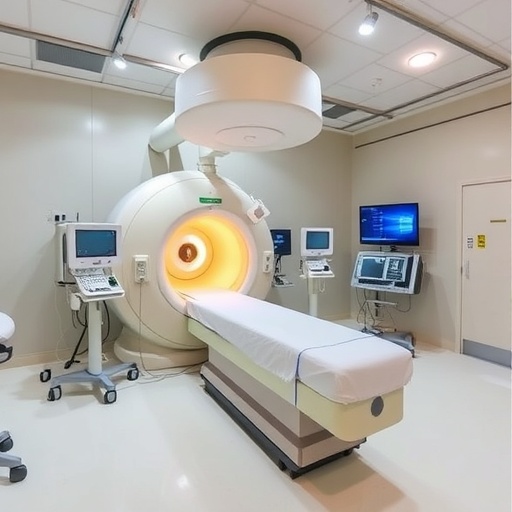Cervical cancer continues to remain a significant health concern globally, particularly in resource-limited settings where advanced medical technologies may not be as readily available. Recent advancements in brachytherapy, notably the use of Cobalt-60 (Co-60) sources for high-dose-rate (HDR) applications, are shedding light on effective treatment possibilities. In a groundbreaking study led by M. El-Doushy and colleagues, the dosimetry evaluation and uncertainty analysis of Co-60 HDR brachytherapy have been rigorously examined, allowing for deeper insights into its potential application for cervical cancer treatment in settings where resources are scarce.
As researchers delve into this complex area, the study underscores the significance of precise dosimetry in ensuring safe and effective cancer treatments. The dosimetry process involves quantifying the radiation dose delivered to a target area, which in this case is the cervix affected by malignancy. Accurate dosimetry is pivotal in brachytherapy, as it ensures that sufficient radiation is administered to eradicate cancer cells while sparing adjacent healthy tissues from unnecessary damage. This delicate balance is critical in achieving optimal treatment outcomes and minimizing side effects.
One of the primary objectives of the study by El-Doushy et al. was to evaluate the dosimetric properties of Co-60 HDR brachytherapy sources. By employing advanced techniques and methodologies, the authors were able to identify key factors influencing radiation dose distribution and its implications for treatment planning. The study meticulously analyzed the relationship between source strength, geometry, and patient-specific anatomical factors, revealing important insights that can guide clinicians in optimizing treatment protocols tailored to individual patients.
Uncertainty in dosimetry is a critical issue that can impact patient outcomes. The authors conducted a comprehensive uncertainty analysis to quantify the potential discrepancies in dose assessment arising from factors such as source calibration, measurement techniques, and patient positioning. This analysis is particularly vital in low-resource settings, where equipment may not be as sophisticated, and operators may have varying levels of experience. By identifying and quantifying these uncertainties, the study aims to enhance the reliability of Co-60 HDR brachytherapy treatments.
The technological aspects of Cobalt-60 brachytherapy are a driving force behind its continued use in cancer treatment. Cobalt-60, a radioactive isotope that emits gamma rays, has proven effective in delivering targeted radiation therapy. Its physical properties allow for a relatively cost-effective means of achieving high dose rates, making it a viable option for treatment in institutions with limited budgets. The research distills the evidence supporting the use of Co-60 sources, advocating for broader integration into therapeutic regimens for cervical cancer.
Moreover, the study sheds light on the potential for Co-60 HDR brachytherapy to be safely and effectively utilized in various clinical scenarios. Through the rigorous evaluation of dosimetric outcomes, the authors present a compelling case for the adaptation of this technology for diverse patient populations. Their findings indicate that when properly calibrated and utilized, Co-60 can provide a robust therapeutic option that holds promise for improved patient survival rates.
Presented within the context of cervical cancer treatment, this research not only highlights the technical challenges associated with brachytherapy but also addresses the practical implications of delivering care in resource-limited environments. As the authors discuss, many facilities worldwide face barriers such as insufficient training for personnel, limited equipment access, and financial constraints that hinder the adoption of advanced techniques. By focusing on Co-60 HDR technology, the study champions innovation in overcoming these obstacles, advocating for methods to enhance treatment pathways.
In addition, the importance of collaborative efforts among researchers, clinicians, and policymakers is emphasized throughout the study. The necessity for sharing best practices, continuous training, and fostering innovation in treatment methodologies cannot be overstated. Development initiatives focusing on Cobalt-60 brachytherapy can lead to improved knowledge dissemination and technological transfer, ultimately contributing to better cancer care and patient outcomes globally.
El-Doushy et al. also address the ethical considerations surrounding brachytherapy in resource-limited settings. They raise significant questions about access to care, the affordability of treatment options, and the importance of ensuring equity within healthcare systems. Through their findings, they advocate for strategic policies that support the implementation of cost-effective technologies, ensuring that effective cancer treatments are not restricted solely to affluent settings.
Looking ahead, the research opens up discussions about the future of brachytherapy and its role in curtailing cervical cancer rates. As awareness of the disease and its impact on women’s health continues to grow, so too does the imperative for innovative and effective treatment options. Cobalt-60 HDR brachytherapy emerges as an encouraging avenue worthy of further exploration, promising to expand the landscape of available therapies.
As researchers build on the findings presented, future studies could explore combinations of Co-60 brachytherapy with other treatment modalities such as chemotherapy or immunotherapy. Understanding how this hybrid approach may amplify therapeutic effects offers exciting prospects for enhancing treatment efficacy. Increased collaborative research and pooled resources could serve to fast-track advancements, shaping the direction of future cervical cancer treatment protocols.
Not only does this study serve as a testament to the potential of Cobalt-60 HDR brachytherapy, but it stands as a rallying call for action. The challenges facing cervical cancer treatment demand innovation, collaboration, and a commitment to improving outcomes for patients worldwide. By harnessing available technologies like Co-60, researchers and clinicians have the opportunity to forge new paths, ensuring that effective cancer treatment becomes an attainable reality for all.
Through the meticulous analysis conducted by M. El-Doushy and his colleagues, an optimistic future for cervical cancer treatment in resource-limited settings is illuminated. Increased understanding of dosimetric evaluation and uncertainty analysis lays a foundation for targeted research and development initiatives. As the field continues to evolve, the integration of technologies like Co-60 brachytherapy can ultimately shape the course of cancer care, driven by the collective goal of saving lives and enhancing health equity.
In conclusion, the findings of this study not only reaffirm the value of Cobalt-60 HDR brachytherapy in addressing cervical cancer but also shine a light on the critical need for ongoing research and commitment to innovation in healthcare. The hope is that the insights gained will inspire further advancements, bringing us closer to a world where effective cancer treatment is universally accessible and disparities in care are diminished.
Subject of Research: Cobalt-60 HDR brachytherapy for cervical cancer in resource-limited settings.
Article Title: Dosimetry evaluation and uncertainty analysis of Cobalt-60 HDR brachytherapy for cervical cancer in resource-limited settings.
Article References:
M. El-Doushy, A., Attalla, E.M., Ibrahim, I.H. et al. Dosimetry evaluation and uncertainty analysis of Cobalt-60 HDR brachytherapy for cervical cancer in resource-limited settings.
J Cancer Res Clin Oncol 151, 247 (2025). https://doi.org/10.1007/s00432-025-06280-0
Image Credits: AI Generated
DOI:
Keywords: Cobalt-60, brachytherapy, cervical cancer, dosimetry, uncertainty analysis, resource-limited settings.
Tags: advancements in cancer care technologycervical cancer treatment in resource-limited areasCobalt-60 brachytherapydosimetry evaluation in cancer therapyeffective treatment for cervical malignancyhigh-dose-rate brachytherapy advancementsminimizing side effects in brachytherapyoptimizing cancer treatment in low-resource settingsprecise dosimetry for optimal outcomesradiation dose delivery in brachytherapysafe cancer treatment methodologiesuncertainty analysis in dosimetry





